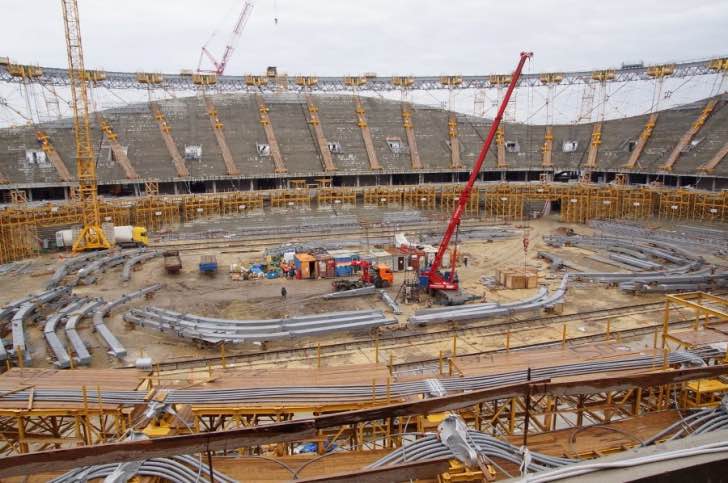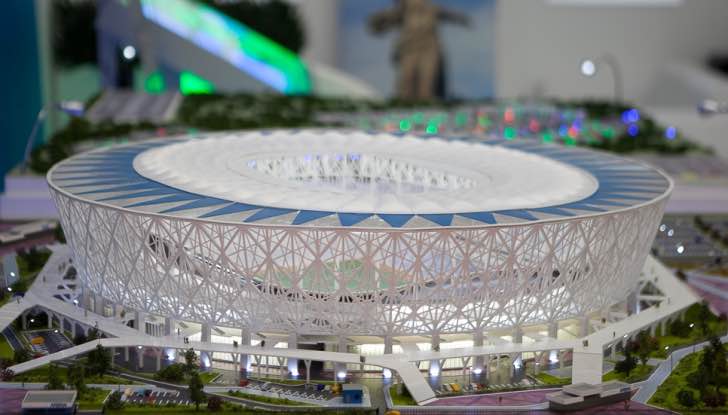Volgograd Arena: FC Rotor Volgograd

By Maximos (Own work) [CC BY-SA 4.0], via Wikimedia Commons
In 1962 Central Stadium opened its doors for the first time in the Russian city of Volgograd. It was designed to be the home of the local team, FC Rotor Volgograd, which had been formed in 1929. The stadium was renovated in 2002 but when Russia won the right to host the 2018 FIFA World Cup a decision was taken to demolish the 32,000 plus seat arena in favour of building a new ground that would be suitable for hosting top-level football. That stadium is Volgograd Arena and the new ground will have over forty-five and a half thousand seats when it opens ahead of the tournament.
The problem with writing stadium guides ahead of the Russia hosted World Cup is that there is scant amount of information out there at the moment. The building of the various football grounds necessary to host such a major tournament has been beset by problems almost across the board, from difficulties with the building of the stadiums through to the clubs intended to use them after the World Cup being relegated from the top-flight. Nevertheless, we’re here to inform you about the different locations that you’ll be visiting if you go to watch any of the World Cup matches, so here’s what we know about the Volgograd Arena to date.
Stats
| Volgograd Arena Stats | |
|---|---|
| Year Opened | 2017 |
| Capacity | 45568 |
| Average Attendance | 40245 |
| Record Attendance | 42189 (Japan v Poland (2018)) |
| Pitch Size | 105x68(7140) |
| Owner | Russian Government |
| Clubs Hosted | FC Rotor Volgograd |
| First Fixture | Tunisia v England (18/06/2018) |
Volgograd Arena Photos



Volgograd Arena Seating Plan and Where to Sit

The stadium’s design is quite modern in appearance, with two tiers stretching around the pitch as continuous seating. The upper tier has a wavy appearance, with more seating in some sections than others. The tiers are separated by a row of executive boxes and other such things that are a requirement of hosting a FIFA event.
Getting To Volgograd Arena
Train – It would take about two and a half days to get a train from London to Volgograd, so it’s probably worth exploring other methods to get there. Once you’re in the city there’s a stop on the underground right next to the Arena. At the moment it’s called Central Stadium Station, but it might well be renamed ahead of the tournament. There’s also a Light Rail Station named Park kul’tury within walking distance.
Bus – Bus numbers 9, 12, 12V and 95 all stop right outside the ground, so they’re the numbers to keep your eye out for.
Car – The E119 and the R228 are the two closest main roads to the arena, though you’ll want to get a sat-nav or similar if you want to get more detailed directions.
By Air – Volgograd International Airport is about twenty miles from the centre of the city, so that’s where you’ll want to fly into if you’re taking the plane to Russia.
Taxi – A taxi from the centre of Volgograd to the stadium should cost about 150 rubles and will likely take about ten minutes to complete its journey, traffic dependent.
Parking Near Volgograd Arena
There are likely to be a number of parking areas close to the Arena, mainly because it’s a brand new location after the demolition of Central Stadium and it’s likely that the planners will have taken the need for parking into account.
Useful Resources
Volgograd Arena Hotels

Marton Rokossovskogo - £30+

Hilton Garden Inn Volgograd - £40+

Park Inn by Radisson Volgograd - £50+
Pubs and Bars Near Volgograd Arena
Paulaner
Barrel Bar
Alhovsky
Hospitality

FIFA require a certain number of hospitality boxes and lounges be in place in order for a venue to host official matches. Whilst complete information isn’t yet available, it’s reasonably safe to assume that there will be a decent number of executive areas within the ground once the tournament is underway. We’ll let you know more information as soon as we have it.
Private Hire
Football stadiums are often a good place to go in a local area if you want to hire a space for business meetings or the like. It would be likely to assume that the Volgograd Arena will be available for such things after the World Cup, so we’ll update this section when we know more.
Stadium Tours & Museum
Until the arena is fully built and officially open we won’t know for sure whether or not you’ll be able to do a tour of it. It’s likely that, even if you can, you won’t be able to until after the World Cup is over. We’ll update this section accordingly.
Volgograd Arena History

The Volgograd Arena hasn’t even opened its doors at the time of writing, so its history is yet to be written. What we do know is that it’s been built on the site of the old Central Stadium, which opened in 1962 as the new home for FC Rotor Volgograd. That ground was demolished in 2014 to make way for the Arena, leaving a short amount of time to clear the area and build the new stadium. The Arena is being built at the foot of the Mamayev Kurgan memorial, which is itself close to the Volga River.
The new stadium is part of a larger complex that includes ten different gyms, some swimming pools and a smaller sports area. There was an intention to build a riding school, but there wasn’t enough money. When the World Cup gets underway the Volgograd Arena will be used for four different Group Stage matches, one from each of Group A, Group D, Group G and Group H. Once the stadium has hosted its first match and we’ve got more to tell you, we’ll update this section accordingly.
Future Developments

In the immediate future the most major development will be the finishing of the stadium and its subsequent official opening. In the longer term the plan is to reduce the capacity from over 45,000 to around the 35,000 mark, with FC Rotor Volgograd using it as their new home.
